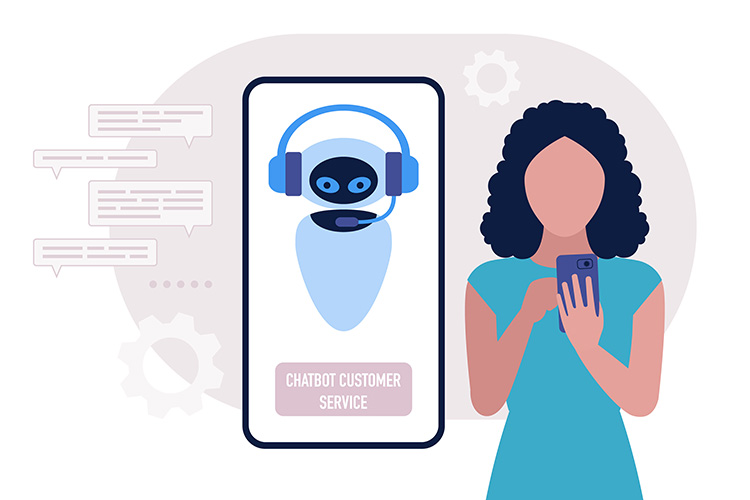Even if you’re not familiar with the term “chatbot,” it’s more than likely that you know one — named Alexa.
Yes, that Alexa. As in, “Alexa, how far is it from Anchorage to Miami?” or “Alexa, where can I watch Game of Thrones?”
In brief, a chatbot is an artificial intelligence (AI) tool that can understand and answer questions.
Beyond the practical (and entertainment) value chatbots like Alexa provide, these technologies are increasingly being adopted in business, especially in customer service settings, where they are often referred to as autonomous customer service agents.
In fact, a recent report by Gartner noted that 2020 revenues in the conversational artificial intelligence provider category were around $2.5 billion and growing at a pace of 75% year over year.
This isn’t surprising to Scott Schanke, Assistant Professor of Information Technology Management, who recently published an article on Estimating the Impact of “Humanizing” Customer Service Chatbots in the journal Information Systems Research.
Schanke says that one of the biggest values that chatbots can provide to firms is ensuring consistent performance.
In many customer service jobs, people are expected to perform routinized tasks with nearly mechanistic efficiency and perfection, he says. “But the reality is that individual workers behave differently from each other, and even the same person varies their behavior over the course of any given day.”
“Our study specifically looked at the impact of anthropomorphizing – or humanizing – chatbots, and how doing so affects things like overall customer experience or completion of transactions,” he says.
For the study, Schanke and his research colleagues worked with a dual-channel clothing retailer to automate its used clothing buy-back process. In that process, the customer describes the used clothes they wish to sell, obtains a cash offer, and (if they accept) prints a shipping label to finalize the transaction.
The researchers randomly assigned four categories to each chat conversation – one with no anthropomorphic features, and the remaining three with differing levels of such features. These included having a “social presence,” where the chatbot has a human name or uses familiar versus formal language. Another feature was to insert communication delays, such as waiting 20 seconds for the chatbot to respond instead of responding instantaneously, thus replicating a human-to-human chat conversation. Finally, they were able infuse humor in the chatbots interactions, such as, “while I process your estimate, would you like to hear a joke?” and, upon the affirmative, telling a fully vetted and appropriate joke.
“We found that humanizing the chatbot’s communication with the customer clearly has a direct and beneficial relationship with transaction outcomes,” he says. “But the findings also gave us reason to believe that adding high levels of anthropomorphism to chatbot conversations isn’t always advisable. For example, in our study, when presenting the customer with a randomly drawn offer, individuals also prove to be more price sensitive when it comes from a highly humanized agent. This may prove that how human you make an agent depends greatly on the context.“
A particularly interesting finding in their study was that chatbots that had names like ‘Customer Service Chatbot’ were deemed more likeable by customers than chatbots that were given a human name.
“We think this is because customers figure out on their own that they aren’t interacting with a human, even if they’re not told that, and might even feel deceived,” Schanke explains. “This is one reason that companies have to consider the full context of the transactions to which they’re applying AI and be fully mindful of customer expectations.”
While it’s unlikely that current conversational technologies will replace the best human customer service agents in the short term, Schanke says that it’s entirely plausible that the use of socially intelligent chatbots can lead to more consistent service delivery and service experiences for customers in the future.
So move over, Alexa. Here comes ‘Customer Service Chatbot’ and its friends (named or unnamed).
The full study, “Estimating the Impact of ‘Humanizing’ Customer Service Chatbots,” Scott Schanke, Gordon Burtsch, and Gautam Ray, was published in Information Systems Research, Vol. 32, No. 3, September 2021, pp. 736-751.
| Research@ LubarFaculty scholarship in the Lubar School of Business spans the business fields and beyond through both theoretical and applied research that is published in leading journals. Here are some of our faculty’s most recent publications: |
| A Performance Analysis of Prediction Intervals for Count Time Series Journal of Forecasting Authors: Annika Homburg, Christian Weiß, Layth C. Alwan, Gabriel Frahm, and Rainer Göb |
| Leveraging Multisource Heterogeneous Data for Financial Risk Prediction: A Novel Hybrid-Strategy- Based Adaptive Method MIS Quarterly Authors: Gang Wang, Gang Chen, Huimin Zhao, Feng Zhang, Shalin Yang, and Tian Lu |
| Together We Rise: How Social Movements Succeed Journal of Consumer Psychology Authors: Gia Nardini, Tracy Rank-Christman, Melissa G. Bublitz, Samantha Cross, Laura A. Peracchio |
| Click here to see more faculty research |
